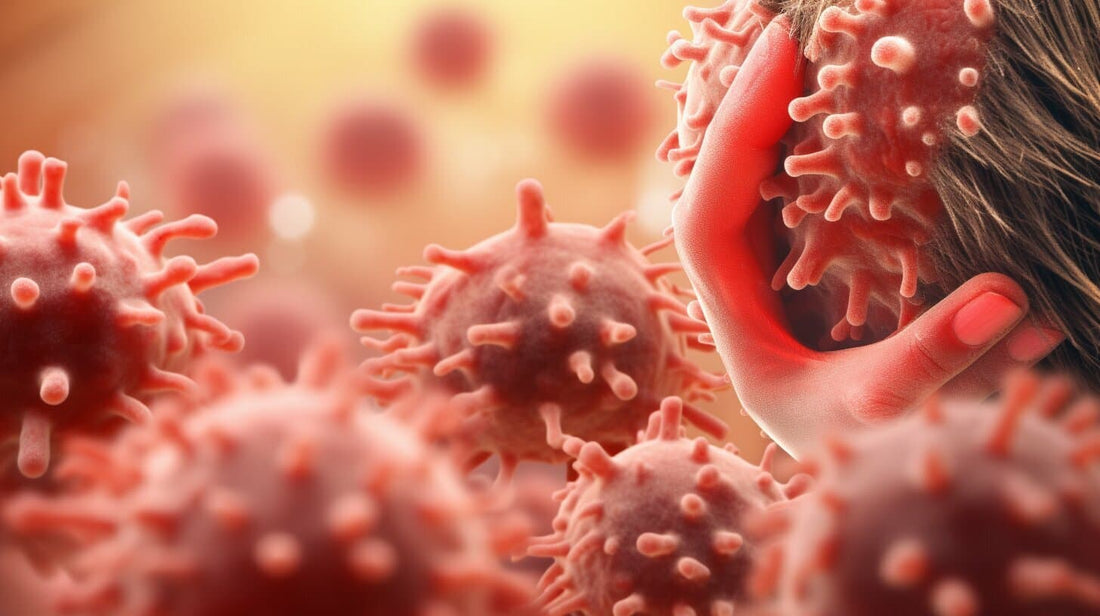Yeast infections are a common problem for dogs. These infections occur when an overgrowth of yeast grows in the dog's body, usually in the ears, paws, or skin folds. Yeast infections in dogs can cause discomfort, itching, and inflammation, so it's essential to recognize the symptoms and seek treatment promptly.
In this article, we'll explore the causes, symptoms, and treatment options for yeast infections in dogs. We'll also discuss natural remedies and preventative measures to help keep your furry friend healthy and happy.

Key Takeaways
- Yeast infections in dogs are caused by an overgrowth of yeast in the body.
- The symptoms of a yeast infection in dogs can include itching, discharge, and inflammation.
- Conventional treatments for yeast infections in dogs include antifungal medications and medicated shampoos.
- Natural remedies such as dietary changes and supplements can also be helpful in treating and preventing yeast infections in dogs.
- Proper hygiene practices and maintaining a balanced diet can help prevent yeast infections in dogs.
Understanding Yeast Infections in Dogs
Yeast infections in dogs occur when the fungi that naturally live on their skin overgrow, resulting in an infection. Dogs with weakened immune systems, allergies, or those taking antibiotics or corticosteroids are more susceptible to yeast infections.
Common symptoms of yeast infections in dogs include itching, redness, and skin irritation. Yeast infections may also cause a foul odor, especially in the ears or paws. If left untreated, the infection can spread to other areas of the body and cause more severe symptoms.
Causes of Yeast Overgrowth in Dogs
Yeast overgrowth can be caused by a variety of factors, such as a poor diet, allergies, or a hormonal imbalance. Dogs that live in hot or humid environments are also more prone to developing yeast infections. Additionally, dogs that have skin folds or floppy ears may have a higher risk of developing a yeast infection due to poor air circulation.
It's important to note that yeast infections in dogs are not contagious to humans or other pets.
Diagnosing Yeast Infections in Dogs
If you suspect that your dog may have a yeast infection, it's important to take them to the veterinarian for an accurate diagnosis. Yeast infections in dogs can be mistaken for other skin conditions, so it's crucial to have them properly examined.
Your veterinarian may conduct various tests and examinations to diagnose the yeast infection, including a skin scraping or cytology, which involves taking a sample of the affected area to view under a microscope. They may also perform a culture test to determine the type of yeast causing the infection and ensure the proper treatment is prescribed.
In some cases, blood tests may be necessary to rule out any underlying health issues that may be contributing to the yeast overgrowth.
Treating Yeast Infections in Dogs
When it comes to treating yeast infections in dogs, there are a variety of options available. The most effective option will depend on the severity of the infection and the underlying cause. In some cases, a combination of treatments may be necessary to fully eradicate the infection.
Conventional treatments for yeast infections in dogs often involve the use of antifungal medications, such as fluconazole, ketoconazole, or terbinafine. These medications can be effective in eliminating the yeast overgrowth, but they may also have side effects or interact with other medications your dog may be taking. Medicated shampoos may also be prescribed to help soothe the skin and reduce inflammation.
If you prefer a more natural approach, there are several home remedies that may help alleviate the symptoms of a yeast infection in dogs. One common remedy is to add apple cider vinegar to your dog's drinking water or use it as a topical treatment on the affected areas. Other natural remedies may include probiotics, coconut oil, and omega-3 fatty acids.
Preventing Yeast Infections in Dogs
Preventing yeast infections in dogs is essential to their overall health and wellbeing. The best way to prevent yeast infections is to maintain good hygiene practices, such as bathing your dog regularly with a gentle shampoo and drying them completely afterward. It's also important to keep your dog's ears clean and dry, as ear infections can often lead to yeast overgrowth.
A balanced diet can also play a role in preventing yeast infections in dogs. Avoid feeding your dog foods that are high in carbohydrates or sugar, as these can contribute to the growth of yeast. Instead, opt for a high-quality, protein-rich diet that is low in grains and other potential allergens.
Conventional Treatments for Yeast Infections in Dogs
When it comes to treating yeast infections in dogs, there are several conventional options available. These treatments include:
| Treatment | Description |
|---|---|
| Antifungal Medications | These prescription medications are designed to combat the overgrowth of yeast in a dog's body. Common medications include fluconazole and ketoconazole. |
| Medicated Shampoos | There are several medicated shampoos available that are formulated to help treat yeast infections in dogs. These shampoos contain antifungal agents that help to reduce yeast overgrowth on the skin. |
It is important to note that while these treatments may be effective in reducing yeast overgrowth, they often come with side effects. Antifungal medications, for example, can cause liver damage or other health issues in some dogs. It is important to discuss potential side effects with your veterinarian before starting any conventional treatment.
Natural Remedies for Yeast Infections in Dogs
Treating yeast infections in dogs can sometimes require more than just conventional medication. Fortunately, there are many natural remedies that can help alleviate symptoms and prevent recurrence.
Probiotics: Probiotics are live microorganisms that can help balance the natural flora in your dog’s gut, and can be especially helpful in preventing yeast overgrowth. You can find probiotic supplements specifically designed for dogs at pet stores or online, or you can try incorporating probiotic-rich foods like kefir or Greek yogurt into your dog’s diet.
Apple Cider Vinegar: Diluted apple cider vinegar can be used as a gentle, all-natural ear cleaner for dogs with yeast infections in their ears. Simply combine equal parts apple cider vinegar and water, soak a cotton ball with the solution, and use it to clean your dog’s ears.
Baking Soda Baths: Baking soda can help soothe itchy, inflamed skin caused by yeast infections. Add a half cup of baking soda to your dog’s bathwater and let him soak for 5-10 minutes before rinsing thoroughly.
Coconut Oil: Coconut oil has natural antifungal properties, making it an effective treatment for yeast infections in dogs. You can try applying coconut oil topically to affected areas or adding a small amount to your dog’s food.
Herbal Remedies for Yeast Infections in Dogs
Herbal remedies can also be effective in treating yeast infections in dogs. Some of the most commonly recommended herbs for this purpose include:
| Herb | Benefits |
|---|---|
| Calendula | Has natural antifungal and anti-inflammatory properties to help soothe irritated skin. |
| Echinacea | Boosts the immune system and can help fight off yeast infections. |
| Goldenseal | Has natural antibacterial and antifungal properties to help combat yeast and other infections. |
It’s important to note that while herbal remedies can be effective, not all herbs are safe for dogs. Always consult with your veterinarian before administering any herbal remedies to your pet.
Preventing Yeast Infections in Dogs
Yeast infections in dogs can be uncomfortable and painful for your furry friend. However, there are ways to prevent them from happening in the first place. Here are some tips:
- Maintain proper hygiene: Keeping your dog clean and dry is key to preventing yeast infections. Make sure to regularly groom your dog and dry them off thoroughly after baths or swimming.
- Provide a balanced diet: A balanced and nutrient-rich diet can help prevent yeast overgrowth in your dog's body. Speak to your vet about the best diet options for your dog's individual needs.
- Avoid overuse of antibiotics: Antibiotics can disrupt the balance of bacteria in your dog's body, leading to an overgrowth of yeast. Only use antibiotics when necessary and as prescribed by your vet.
- Address any underlying health conditions: Certain health conditions, such as allergies or hormonal imbalances, can increase your dog's risk of developing yeast infections. Work with your vet to manage any underlying conditions and prevent future infections.
By following these tips, you can help ensure your dog stays healthy and happy, free from the discomfort of yeast infections.

Yeast Infections in Dogs: Ear Infections
While yeast infections can occur anywhere on a dog's body, they are especially common in the ears. In fact, ear infections are one of the most frequently diagnosed yeast infections in dogs.
Symptoms of ear yeast infections include shaking of the head, scratchy and irritated ears, and a foul smell. These infections can be caused by a buildup of wax, moisture, or allergies.
There are several treatment options available for ear yeast infections, including medicated ear drops, antifungal medications, and specialized diets. Your veterinarian can recommend the best course of treatment for your dog based on the severity of the infection and their overall health.
It is important to address ear yeast infections promptly, as they can lead to more serious complications if left untreated. For example, chronic inflammation in the ears can cause permanent damage and hearing loss.
If you suspect your dog may have an ear yeast infection, it is important to consult with your veterinarian as soon as possible. With proper treatment and care, your furry friend can make a full recovery and return to their happy, healthy self.
Complications of Yeast Infections in Dogs
Yeast infections in dogs may seem like a minor issue, but if left untreated, they can lead to serious complications. Yeast overgrowth in a dog's body can weaken their immune system and make them more susceptible to other infections. Below are some of the potential complications that can arise:
| Complication | Description |
|---|---|
| Chronic inflammation | If a yeast infection is not cleared up, it can cause chronic inflammation of the affected area. This can lead to discomfort for the dog and may require more aggressive treatment. |
| Secondary skin infections | The inflammation caused by a yeast infection can create an environment that is conducive to the growth of bacteria. This can lead to secondary skin infections that require additional treatment. |
| Systemic infection | In rare cases, a severe yeast infection in a dog can become systemic and spread throughout their body, leading to more serious health issues. This is more common in dogs with weakened immune systems or underlying health conditions. |
It's important to seek veterinary care if you suspect that your dog has a yeast infection. With proper treatment, most yeast infections in dogs can be cleared up quickly and without complications.
Conclusion
Yeast infections in dogs can be uncomfortable and frustrating for both pets and their owners. Fortunately, with proper care and treatment, most cases can be effectively managed or even prevented altogether.
If you suspect your dog may have a yeast infection, it is important to seek guidance from a veterinarian. They can help diagnose the issue and recommend appropriate treatment options based on your pet's individual needs.
Whether you opt for conventional medications or natural remedies, following a regular care routine that includes proper hygiene practices, a balanced diet, and regular check-ups can go a long way in preventing yeast infections in dogs.
Remember, a healthy dog is a happy dog!
FAQ
Q: What are the causes, symptoms, and treatment options for yeast infections in dogs?
A: Yeast infections in dogs can be caused by a variety of factors, including underlying health conditions, allergies, or a weakened immune system. Common symptoms of yeast infections in dogs include itching, redness, and a foul odor. Treatment options for yeast infections in dogs can range from conventional medications to natural remedies.
Q: What are the symptoms of yeast infection in dogs and what causes yeast overgrowth in their bodies?
A: The symptoms of yeast infections in dogs may include itching, scratching, redness, and skin rashes. Yeast overgrowth in their bodies can be caused by factors such as allergies, a weakened immune system, or poor hygiene.
Q: How are yeast infections in dogs diagnosed?
A: Veterinarians diagnose yeast infections in dogs through various tests and examinations. These may include skin scrapings, cytology, or culturing samples from affected areas.
Q: What are the different treatment options for yeast infections in dogs?
A: There are various treatment options available for yeast infections in dogs. Conventional treatments may include antifungal medications and medicated shampoos. Natural remedies such as dietary changes and herbal supplements can also be effective in treating yeast infections in dogs.
Q: What are the conventional treatment options for yeast infections in dogs?
A: Conventional treatment options for yeast infections in dogs may include the use of antifungal medications prescribed by veterinarians, as well as the use of medicated shampoos that help to alleviate symptoms and kill yeast.
Q: Are there any natural remedies for yeast infections in dogs?
A: Yes, there are natural remedies that can help alleviate yeast infections in dogs. These may include dietary changes, such as feeding a low-carbohydrate diet, and the use of herbal supplements with antimicrobial properties.
Q: How can yeast infections in dogs be prevented?
A: Yeast infections in dogs can be prevented by practicing proper hygiene, such as regular bathing and cleaning of ears, and maintaining a balanced diet. It is also important to address any underlying health conditions that may contribute to yeast overgrowth.
Q: What are the symptoms, causes, and treatment options for ear yeast infections in dogs?
A: Ear yeast infections in dogs can cause symptoms such as itching, redness, and discharge. Common causes include allergies, moisture in the ears, or a weakened immune system. Treatment options may include antifungal medications, ear cleansers, and addressing any underlying causes.
Q: What are the potential complications of untreated yeast infections in dogs?
A: Untreated yeast infections in dogs can lead to complications such as secondary skin infections, chronic inflammation, and discomfort. It is important to seek veterinary care to prevent further complications.


